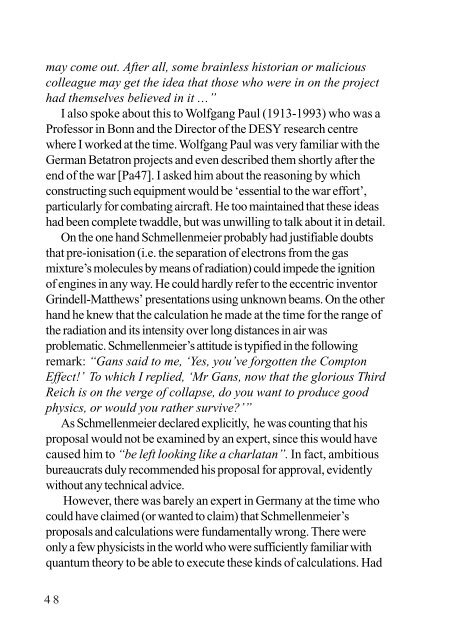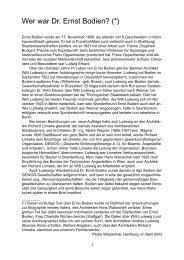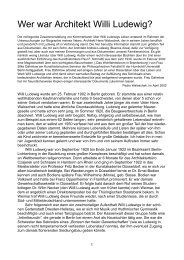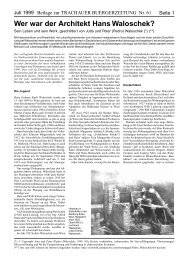Death-Rays as Life-Savers in the Third Reich - Pedro Waloschek ...
Death-Rays as Life-Savers in the Third Reich - Pedro Waloschek ...
Death-Rays as Life-Savers in the Third Reich - Pedro Waloschek ...
You also want an ePaper? Increase the reach of your titles
YUMPU automatically turns print PDFs into web optimized ePapers that Google loves.
may come out. After all, some bra<strong>in</strong>less historian or malicious<br />
colleague may get <strong>the</strong> idea that those who were <strong>in</strong> on <strong>the</strong> project<br />
had <strong>the</strong>mselves believed <strong>in</strong> it …”<br />
I also spoke about this to Wolfgang Paul (1913-1993) who w<strong>as</strong> a<br />
Professor <strong>in</strong> Bonn and <strong>the</strong> Director of <strong>the</strong> DESY research centre<br />
where I worked at <strong>the</strong> time. Wolfgang Paul w<strong>as</strong> very familiar with <strong>the</strong><br />
German Betatron projects and even described <strong>the</strong>m shortly after <strong>the</strong><br />
end of <strong>the</strong> war [Pa47]. I <strong>as</strong>ked him about <strong>the</strong> re<strong>as</strong>on<strong>in</strong>g by which<br />
construct<strong>in</strong>g such equipment would be ‘essential to <strong>the</strong> war effort’,<br />
particularly for combat<strong>in</strong>g aircraft. He too ma<strong>in</strong>ta<strong>in</strong>ed that <strong>the</strong>se ide<strong>as</strong><br />
had been complete twaddle, but w<strong>as</strong> unwill<strong>in</strong>g to talk about it <strong>in</strong> detail.<br />
On <strong>the</strong> one hand Schmellenmeier probably had justifiable doubts<br />
that pre-ionisation (i.e. <strong>the</strong> separation of electrons from <strong>the</strong> g<strong>as</strong><br />
mixture’s molecules by means of radiation) could impede <strong>the</strong> ignition<br />
of eng<strong>in</strong>es <strong>in</strong> any way. He could hardly refer to <strong>the</strong> eccentric <strong>in</strong>ventor<br />
Gr<strong>in</strong>dell-Mat<strong>the</strong>ws’ presentations us<strong>in</strong>g unknown beams. On <strong>the</strong> o<strong>the</strong>r<br />
hand he knew that <strong>the</strong> calculation he made at <strong>the</strong> time for <strong>the</strong> range of<br />
<strong>the</strong> radiation and its <strong>in</strong>tensity over long distances <strong>in</strong> air w<strong>as</strong><br />
problematic. Schmellenmeier’s attitude is typified <strong>in</strong> <strong>the</strong> follow<strong>in</strong>g<br />
remark: “Gans said to me, ‘Yes, you’ve forgotten <strong>the</strong> Compton<br />
Effect!’ To which I replied, ‘Mr Gans, now that <strong>the</strong> glorious <strong>Third</strong><br />
<strong>Reich</strong> is on <strong>the</strong> verge of collapse, do you want to produce good<br />
physics, or would you ra<strong>the</strong>r survive?’”<br />
As Schmellenmeier declared explicitly, he w<strong>as</strong> count<strong>in</strong>g that his<br />
proposal would not be exam<strong>in</strong>ed by an expert, s<strong>in</strong>ce this would have<br />
caused him to “be left look<strong>in</strong>g like a charlatan”. In fact, ambitious<br />
bureaucrats duly recommended his proposal for approval, evidently<br />
without any technical advice.<br />
However, <strong>the</strong>re w<strong>as</strong> barely an expert <strong>in</strong> Germany at <strong>the</strong> time who<br />
could have claimed (or wanted to claim) that Schmellenmeier’s<br />
proposals and calculations were fundamentally wrong. There were<br />
only a few physicists <strong>in</strong> <strong>the</strong> world who were sufficiently familiar with<br />
quantum <strong>the</strong>ory to be able to execute <strong>the</strong>se k<strong>in</strong>ds of calculations. Had<br />
48











